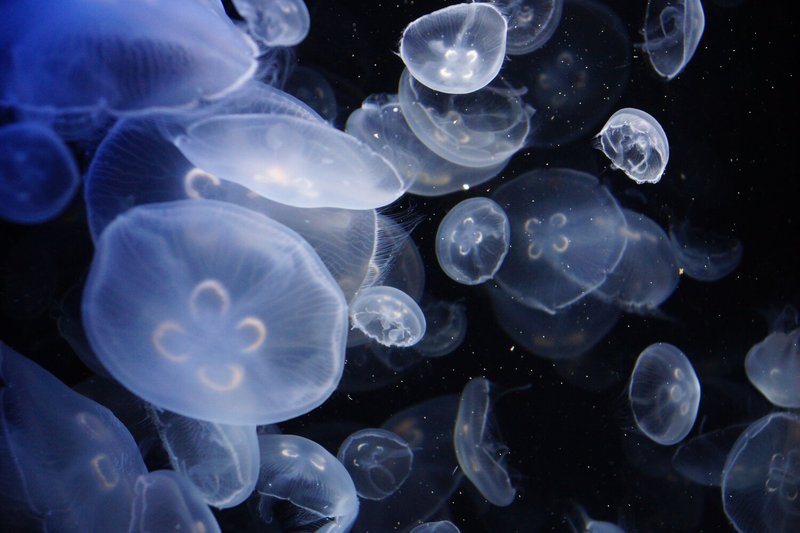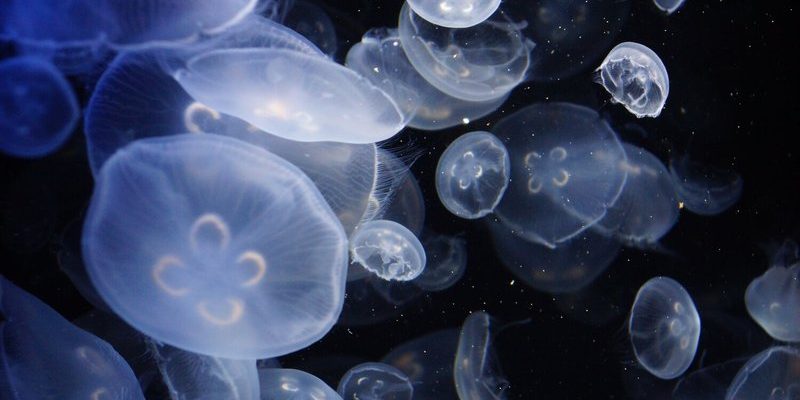
Moon jellyfish, also known as *Aurelia aurita*, thrive in coastal waters around the world. However, just like many marine animals, they face threats from pollution, climate change, and habitat loss. Let’s take a closer look at their conservation status and what’s being done to protect these fascinating creatures.
Understanding Moon Jellyfish
Moon jellyfish are known for their unique appearance. With a bell-shaped, semi-transparent body and trailing tentacles, they can be mesmerizing to watch. They usually measure between 10 to 16 inches in diameter, and their coloration can range from a light, almost invisible hue to a pale purple. You might find them floating calmly in the shallow coastal waters or sometimes washing up on shore.
These jellyfish are important to marine ecosystems, serving as both predators and prey. They feed on small plankton and, in turn, become food for larger species such as sea turtles and certain fish. As you can see, they’re a crucial part of the ocean’s food web—kind of like the glue that holds everything together in their watery world.
Current Conservation Status
As of now, moon jellyfish are not classified as endangered. In fact, they are considered to have a stable population. However, this doesn’t mean they’re completely out of danger. While their numbers might not be dwindling at a concerning rate, environmental shifts and human activities pose significant threats.
Climate change remains one of the biggest challenges. Rising ocean temperatures can affect jellyfish reproduction rates and their habitat. If the water temperature continues to rise, it could lead to changes in the distribution of plankton, which means less food for moon jellyfish. Additionally, ocean acidification—a result of increased carbon dioxide levels—can harm the growth of their jelly-like bodies.
Threats to Moon Jellyfish
Despite their current stable status, moon jellyfish are not immune to various threats. Here are some of the main issues they face:
- Pollution: Plastics and chemicals entering the ocean can disrupt the delicate balance of marine ecosystems and harm jellyfish populations.
- Climate Change: As mentioned, rising temperatures and changing ocean conditions can impact their habitats and food sources.
- Overfishing: Although moon jellyfish aren’t typically targeted by fishermen, overfishing can disrupt the food chain and lead to imbalances in marine life.
It’s clear that even seemingly stable species like the moon jellyfish are affected by wider environmental issues. Keeping an eye on their situation is essential to ensuring their continued survival.
Conservation Efforts
So, what’s being done to protect moon jellyfish and their habitats? Several initiatives focus on promoting marine conservation and reducing pollution. Many organizations work tirelessly to raise awareness about ocean health and the importance of jellyfish in the ecosystem.
For example, projects aimed at cleaning up plastic waste from oceans can significantly benefit all marine life, including moon jellyfish. When we reduce pollution, we help ensure that their natural habitat remains safe and healthy. Plus, promoting sustainable fishing practices can further protect the delicate balance of marine ecosystems.
Not to forget, research is crucial. Scientists are studying moon jellyfish to better understand their biology and behavior. This knowledge can help inform conservation strategies and gauge how they might respond to climate changes.
The Role of Aquariums and Education
Aquariums play a pivotal role in jellyfish conservation. By housing and showcasing moon jellyfish, they not only educate the public about these creatures but also promote conservation efforts. Visitors often leave with a newfound appreciation for marine life, which can lead to greater advocacy for ocean health.
Additionally, educational programs that focus on the environment can inspire people to take action. Simple lifestyle changes, like reducing plastic use and supporting sustainable seafood, can collectively make a huge difference.
How You Can Help
You might be wondering, “What can I do to help moon jellyfish?” Here are a few simple yet effective actions you can take:
- Reduce Plastic Use: Opt for reusable bags, bottles, and containers to cut down on waste.
- Participate in Cleanups: Join beach clean-up events to help remove debris from the ocean.
- Spread Awareness: Share information about jellyfish and marine conservation on social media or within your community.
Even small changes can lead to larger impacts, and encouraged conservation advocates can create a ripple effect.
Final Thoughts
Moon jellyfish may not be endangered right now, but the challenges they face remind us of the fragile state of our oceans. It’s essential to stay informed and support efforts that promote their survival and the health of marine ecosystems. By doing our part, we can ensure that future generations can enjoy the mesmerizing beauty of jellyfish and the vibrant life within our oceans.
Let’s continue to learn, advocate, and protect our planet. Every action counts, and together, we can make a difference!

